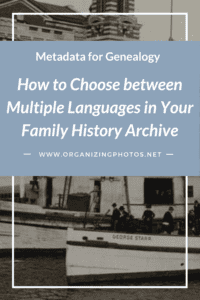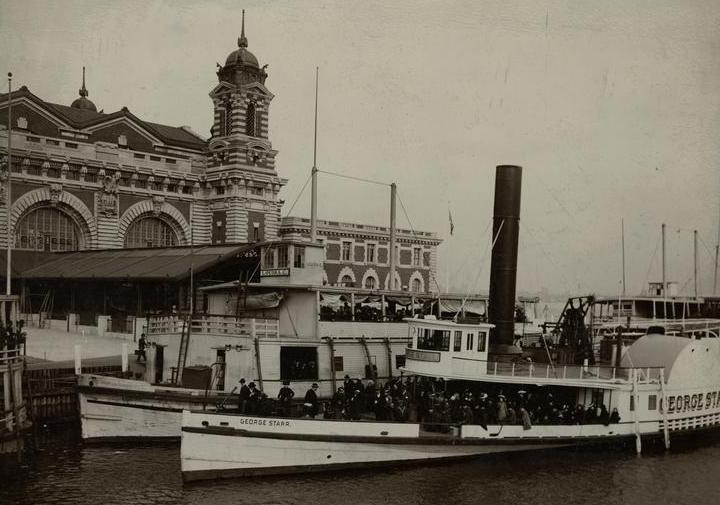In this final series post on metadata for genealogy, we consider how to choose between multiple languages in your family history archive. How do we decide what language to write in, and why? This is something that our international clients often get stuck on, so what better way to round out this series than to explore how to make that choice. Read on, my multilingual friend!
We All Have Different Cultural influences
Whether we acknowledge it or not, we all have multiple cultural influences that show up in daily life – from deep-rooted traditions and beliefs to more light-hearted celebrations. For some, it’s superficial, like celebrating another culture because we like it and recognize its importance (Hello St. Patrick’s Day!), but for others, it’s deeper than that.
For many people throughout the world, being multicultural and multilingual is simply a matter of fact. Growing up in Europe, this was always a big part of my life. I spoke different languages with friends based upon what side of the border they lived on, and we learnt many of those languages in school. Once I started exploring my family history, I also saw historical influences come in strong, and I realized that my family wasn’t as homogenous as I had previously thought.
Perhaps you have come to the same realization working on your family history archive? Maybe you have heritage from England, Italy, Germany, Poland, Ireland, or some other foreign country? If your ancestors arrived at Ellis Island, you likely do. Perhaps you have captions on the backs of old photos that tell a story you haven’t yet included in your archive? As many of my students in Searching Sweden found out, we often have very strong cultural and linguistic backgrounds in our family tree, and we want to account for them in the best possible way.
How do we properly represent multiple languages and cultures in our family history archives, especially when embedding metadata into our photos?
That’s what we’ll explore together today.

I’m a Perfect Pinnable!
Language Choices
When we (as professionals) work with culturally-blended family history archives, we tend to look at six different considerations to guide our choice when it comes to using multiple languages vs. one language. I want to walk you through those six considerations in this article, using my own family history archive as an example. Hopefully, that will help you think about what the answer might be for your archive.
Let’s jump into these six key questions:
1. Do We Really Need to Include Multiple Languages?
The first question to ask is: do we really need to include multiple languages in our family history archive?
This is our first consideration because if the answer is clear a “No,” we can stop right here, and agonize over it no more. However, if the answer isn’t immediately obvious to you, we need to look at a few more key factors in order to get to the right decision. A “yes” complicates things, but also makes the archive culturally vibrant and exciting.
Caroline’s Considerations
In my case, the answer was not obvious because I straddle two continents and several languages – and that’s only from my own journey! Add to that, an archive rich in media and family history details that go back hundreds of years. It was definitely not an obvious choice, and I had to give it some thought. With that in mind, let’s move on to the next consideration.
2. Who is the intended audience?
The second thing to think about is your audience. Who is the intended audience for your efforts? Will it be only you? Your children? Grandchildren? Your parents? Other relatives? A museum? An organization?
Knowing the answer is key because we want to make sure that the archive is usable for them, so they can receive the benefit of using it. We all know what a struggle it can be to make sense of things in a language that you don’t speak fluently, so we need to be mindful here. If your combined audience speaks only one main language, your decision may be easy enough, but what if your audience speaks multiple languages?
Caroline’s Considerations on Audience
My own family is a perfect example of this scenario. We have a very international family with many countries of birth and many cultural influences, and moreover, there’s a multitude of people who want to experience and enjoy our shared family history archive. Some of the multiple languages I have to consider are: Swedish, Danish, Norwegian, English, Tamil, and Telugu.
How do I best choose what to include?
Well, to answer that question, we have to continue to the next consideration.
3. Is the Archivist Linguistically and Culturally Fluent?
Besides thinking about the audience, we also have to think about the person who will be maintaining the archive. That person should ideally be fluent in the language and culture in question. When organizing photos, I have to be able to understand what holidays are being celebrated, what ceremonies are happening, etc.. We need more than just basic language skills. Cultural fluency is of the essence.
Again, if you’re only dealing with an audience and a designated historian that comes from the same culture and speaks the same language as the rest of the audience, this won’t be a difficult choice to make. However, if you expect your audience to be mixed, and your archivist doesn’t speak the same language (or have knowledge of how that culture functions), that person will have a difficult task in front of them.
Caroline’s Considerations on Fluency
If I were to maintain my husband’s family history archive, could I do it? Let’s see. Am I culturally fluent? Enough, I’d say. I recognize all major events and have a good understanding of what happens at all Indian ceremonies and gatherings. But the language? No, that’s where it falls apart. I can say a few select words Tamil and Telugu, sure…but maintaining a family history archive accurately in those languages requires a lot more skill than that. I have to be able to decipher captions and other writings, and that is too difficult.
Therefore, Tamil and Telugu fell off here as main language options in my own family history archive. Doing what I do, there was no question that I would be the designated family historian, so it wouldn’t make sense for me to write mainly in those languages. They can be present in the archive, but we decided they have to be outsourced and translated into another main language.
Based on this decision, I had narrowed it down to four other possibilities: Swedish, Norwegian, Danish, and English. Continue reading to see how I proceeded.
4. What Language Makes the Contents More Accurate?
Is the contents in your archive more accurate in another language or script? Sometimes, that’s the case.
I’ll give you a great example that we come across all the time, albeit with slight variations. Let’s say that you have a Swedish ancestor and he’s named “Jöns Åkesson,” a very common name. If your archive was in Swedish, you’d never question the usage of those two Swedish letters, would you? …but in English, do we include them?
In a scenario like this, keeping it in Swedish is by far the most accurate because if you write “Jöns Åkesson” as “Jons Akesson” without the extra dots, it becomes a totally different name. The American letter “O” is a very different letter than the Swedish “Ö.” Same with “A.” The letter “A” is not the same as an “Å.” They may look similar, but they’re not.
This is where my point about the archivist comes into focus. An archivist who isn’t culturally and linguistically fluent may not know the difference, and will then include inaccurate information. If you then try to research that person with an inaccurate name, you won’t get any hits. Enter the genealogical brick wall.
So the question becomes, what main language makes the content of the family history archive more accurate?
Caroline’s Considerations on Contents
In my archive, this was easy to figure out. The majority of the content we have is in Swedish, so logically, it was a case of “majority rules.” We do have content in Danish, Norwegian, and English too, but not as much. Therefore, it made the most sense to use Swedish as the main language. It’s also my native languages, making it easy for me to navigate (see point #3).
But we weren’t done here.
5. What Script, Formatting, and Spelling Choices Make Sense?
When making a language choice, you also have to define your script, formatting, and spelling choices for consistency.
In various languages, the script is different, so you have to consider how you will treat the language, especially if you don’t have an archivist that’s 100% fluent.
A great example of this is one of our client archives. With her being from Egypt, the correct script to use would be Arabic script rather than the latin (english) version. In other words, should I write “القاهرة” as they do in Cairo, or would I write “Cairo” as we do in the english-speaking world? Well, it depends. An archivist with fluency would (and should) probably opt for Arabic script. An archivist that’s not fluent (i.e. me) would likely make a lot of mistakes, which would make the archive worse off than if it was in latin script.
You might think this is a far-fetched example, but you’d be surprised how often these types of issues pop up, especially considering how most cultures have evolved from phonetic spelling to standardized spelling. You probably have a dozen photos and records in your archive with phonetic spelling in them – will you transcribe them as-is, or modernize them? How does that choice change the context?
Issues like this can always be solved, but you shouldn’t have to struggle with it the whole way through your project. It’s much easier to make script, formatting, and spelling choices that align with the archivist. However, we have to remember, acknowledge, and document how those choices affect the historical and cultural accuracy of the content.
Caroline’s Considerations on Formatting
In my own archive, I decided to go with modern Swedish spelling and formatting choices rather than older versions of the language (Sweden has gone through several spelling reforms over the years). So, for example, instead of writing “Ysted,” which is the name of my hometown in older records, I write the modern version “Ystad” – the way it’s known now. I have chosen to exclude older and phonetic spelling choices in my keyword lists, but include and explain them in captions, descriptions, transcriptions, and such. Easy and straightforward, yes, but best of all – explained.
6. Do We Need a Secondary Language for Translation Purposes?
In some archives, especially those that have an audience of mixed heritage and language backgrounds, it’s smart to have a secondary language included for translation purposes.
Introducing a second language into the mix means that you’ll have all of your titles, captions, descriptions, transcriptions, etc. in your main language, but you would also translate them into a second language and include that as well. This is so that the meaning would be apparent to everyone, and allow you to hand off the archive to someone else without having to personally translate and explain everything. Is it absolutely necessary to include multiple languages? No, of course not. But it is appreciated. It facilitates the usability of the archive in the long-run.
Imagine if I inherited a family archive in Greek – a language that I don’t speak. How much would I derive from it? It would be very difficult to connect the dots, wouldn’t it? But what if that archivist had also included translations? That would be a useable goldmine of information. This is my point entirely. Imagine what we would know about ancient civilizations if we knew the full context of their languages. The context around our discoveries would be so much greater. A language unlocks so many insights, so make it easy for people to understand your memories.
Caroline’s Considerations on Translations
As I stated earlier, my own family history archive is in Swedish, but since many of my family members don’t speak Swedish fluently, I decided to add English as a secondary language. This means that every caption, description, and transcription comes with a translation below it. Does it take a little longer to complete? Yes, absolutely. Yet, I feel like it’s important to make sure that my intended audience will be able to enjoy my efforts. Another 10% of extra work will yield 100% enjoyment for many others, and that is worth it. Plus, it gives me reassurance that once I’m gone, my daughter and other family members will be able to keep maintaining the archive without having any issues. Multiple languages = multiple benefits.
Document the Use of Multiple Languages in Your Photo Archive
When putting together your metadata strategy, be sure to include a note on what your main language is, and whether or not you have chosen to include a secondary one. Indicate what formatting and spelling choices you have made and why. This will be invaluable information for future generations to reference.
We often believe that things will be the same in the future, or that things will be obvious to someone else, but I assure you, they won’t be. Just as I have benefited from learning about the past from my ancestors, I hope to have others learn from me. It’s my intention to create a family history archive that’s not only full of photos, but also full of culture and originality. In other words, encompassingly accurate as a personal time capsule.
Want to Learn How to Strategize Better?
If you’re interested in learning more about creating your own metadata strategy, consider enrolling in our Metadata for Genealogy Workshop. We held it last year during family history month, and the replay is available for anyone who may have missed it. See the preview below.
This is by far our most popular workshop, and in it, you’ll learn exactly what IPTC metadata fields to use, and what to consider when putting together your own family archive metadata strategy (simple template included). Naturally, all of my recommendations are in there too, so you have references and a place to start.
For more in-depth help that starts from the absolute beginning, consider joining us in our full course DPO PRO: The Ultimate Photo Organizing Masterclass. That’s where we strategize together, and help you through each step of the photo organizing process. We also have private coaching sessions available for anyone who’d like to fool-proof their procedures.
In a nutshell, if you’re gonna do it, spend your time doing it right, so that you can create the legacy your family history deserves.
Did You Miss the Other Articles in This Series?
This article rounds out our series on metadata for genealogy, and just in case you missed any of the other ones, here is a complete list for you (tip: read them in order!):
- Metadata for Genealogy, Part One: The Only Way to Prevent Metadata Inconsistencies in Your Family Photo Archive
- Metadata for Genealogy, Part Two: 8 Factors that Define Naming Conventions in Your Photo Metadata Strategy
- Metadata for Genealogy, Part Three: Use These 7 ITPC Metadata Fields in Your Family Photo Archive
- Metadata for Genealogy, Part Four: Handling Photo Locations & Historical Border Changes
- You are here
Featured Photo Courtesy of NYPL Digital Collections





